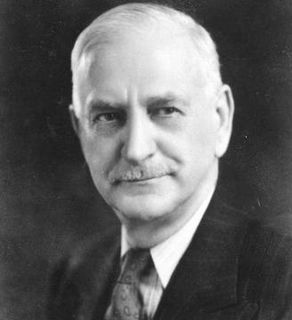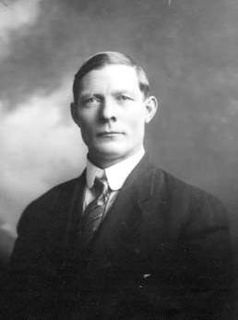The 1913 municipal election was held December 8, 1913 to elect a mayor and five aldermen to sit on Edmonton City Council, trustees to sit on the public school board, and four trustees to sit on the separate school board.
The 1922 municipal election was held December 11, 1922 to elect a mayor and six aldermen to sit on Edmonton City Council and three trustees to sit on the public school board. R Crossland, P M Dunne, Joseph Gariépy, and J J Murray were acclaimed to two-year terms on the separate school board.
The 1926 municipal election was held December 13, 1926, to elect a mayor and six aldermen to sit on Edmonton City Council and three trustees to sit on the public school board. Harry Carrigan, J O Pilon, and W D Trainor were acclaimed to two-year terms on the separate school board.
The 1929 municipal election was held December 9, 1929 to elect a mayor and five aldermen to sit on Edmonton City Council and four trustees to sit on the public school board, while four trustees were acclaimed to the separate school board). In the election's only plebiscite, voters didn't endorse the extension of the half day Wednesday shopping holiday by the required two-thirds majority.
The 1930 municipal election was held November 12, 1930 to elect a mayor and five aldermen to sit on Edmonton City Council and four trustees to sit on the public school board, while three trustees were acclaimed to the separate school board. This was the first election to be held in November; where elections had previously been held on the second Monday of December, beginning in 1930 they were held on the second Wednesday of November to encourage voter turnout.
The 1931 municipal election was held November 11, 1931 to elect a mayor and five aldermen to sit on Edmonton City Council and four trustees to sit on the public school board, while four trustees were acclaimed to the separate school board.
The 1932 municipal election was held November 9, 1932 to elect a mayor and five aldermen to sit on Edmonton City Council and three trustees to sit on the public school board, while three trustees were acclaimed to the separate school board.
The 1934 municipal election was held November 14, 1934 to elect a mayor and six aldermen to sit on Edmonton City Council and three trustees to sit on each of the public and separate school boards.
The 1936 municipal election was held November 12, 1936 to elect a mayor and five aldermen to sit on Edmonton City Council and three trustees to sit on the public school board, while three trustees were acclaimed to the separate school board. Voters also rejected a proposal to extend the mayor's term to two years. The election would normally have been held on November 11, but was delayed by a day owing to the Armistice Day holiday.
The 1937 municipal election was held November 10, 1937 to elect a mayor and six aldermen to sit on Edmonton City Council and five trustees to sit on the public school board, while four trustees were acclaimed to the separate school board. Voters also decided three plebiscite questions.
The 1938 municipal election was held November 9, 1938 to elect a mayor and five aldermen to sit on Edmonton City Council and three trustees to sit on the public school board, while three trustees were acclaimed to the separate school board. Voters also rejected two proposals to borrow money from other levels of government for the construction of new housing.
The 1939 municipal election was held November 8, 1939 to elect a mayor and five aldermen to sit on Edmonton City Council. Elections for school trustees were not held, as candidates for both the public and separate boards were acclaimed.
The 1940 municipal election was held November 13, 1940 to elect a mayor and seven aldermen to sit on Edmonton City Council. Elections for school trustees were not held, as candidates for both the public and separate boards were acclaimed.
The 1941 municipal election was held November 12, 1941 to elect a mayor and five aldermen to sit on Edmonton City Council and four trustees to sit on the public school board, while four trustees were acclaimed to the separate school board.
The 1942 municipal election was held November 12, 1942 to elect a mayor and five aldermen to sit on Edmonton City Council, three trustees to sit on the public school board and five trustees to sit on the separate school board. Voters also approved an eight-hour day for firefighters. The election would normally have been held on November 11, but was delayed by a day owing to the Armistice Day holiday.
The 1943 municipal election was held November 10, 1943 to elect a mayor and five aldermen to sit on Edmonton City Council and four trustees to sit on the public school board, while four trustees were acclaimed to the separate school board.
The 1944 municipal election was held November 1, 1944 to elect a mayor and five aldermen to sit on Edmonton City Council and three trustees to sit on the public school board, while three trustees were acclaimed to the separate school board. This was the first election to be held on the first Wednesday of November rather than the second Wednesday, in order to avoid future conflicts with the Armistice Day holiday, as happened in 1936 and 1942.
The 1945 municipal election was held November 7, 1945 to elect a mayor and five aldermen to sit on Edmonton City Council and five trustees to sit on the public school board, while four trustees were acclaimed to the separate school board.
The 1947 municipal election was held November 5, 1947 to elect a mayor and five aldermen to sit on Edmonton City Council and four trustees to sit on the public school board, while four trustees were acclaimed to the separate school board. Voters also voted on two plebiscites, one of which approved two-year mayoral terms. Accordingly, Harry Ainlay's election made him the first mayor of Edmonton to serve a two-year term.
The 1948 municipal election was held November 3, 1948 to elect five aldermen to sit on Edmonton City Council. There was no mayoral election, as Harry Ainlay was in the second year of a two-year term. There were no elections for school trustees, as candidates for both the public and separate boards were acclaimed.




